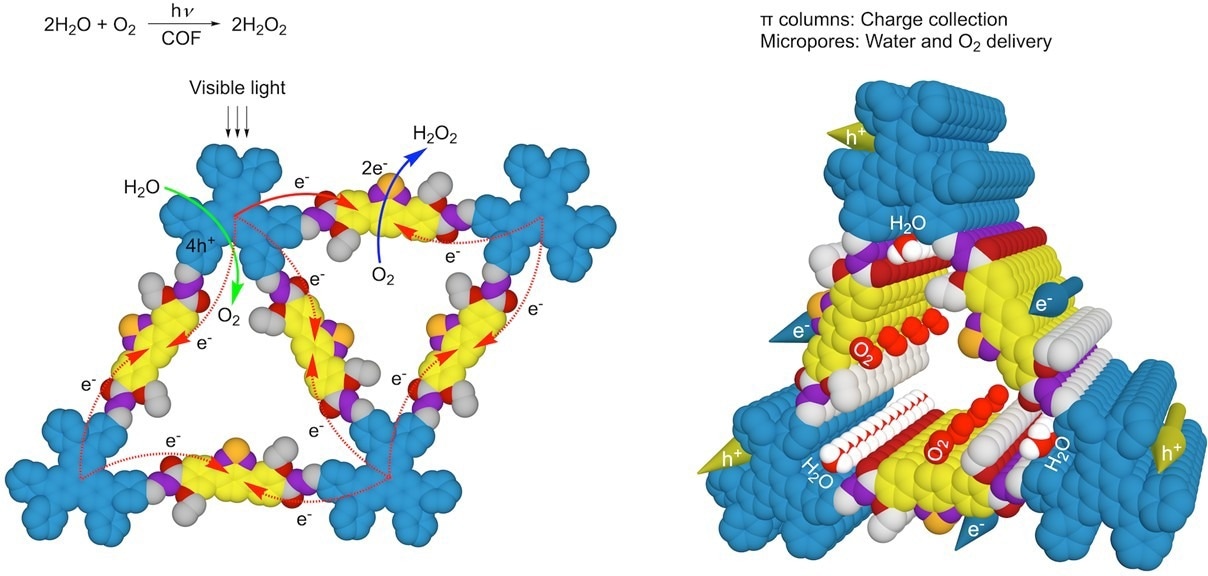Reviewed by Lexie CornerFeb 29 2024
Researchers at the National University of Singapore (NUS) have created a microporous covalent organic framework with dense donor-acceptor lattices and tailored links for the clean and effective photosynthesis process that produces hydrogen peroxide (H2O2).
 The illustration shows a newly designed hexavalent covalent organic framework (COF) material that mimics photosynthesis. (Left figure) Light triggers the transfer of an electron from a donor site to an acceptor site within the material (indicated by red arrows). This process transfers four positive charges to the donor site, which are then used to split water molecules into oxygen (indicated by green arrows). At the acceptor site, two electrons combine with oxygen to produce hydrogen peroxide (indicated by the blue arrow). (Right figure) The structure of the material allows for efficient movement of electrons (shown in yellow), positive charges (shown in blue), water, and oxygen throughout the single layer. This material has the potential to convert light energy into chemical energy in a similar way to natural photosynthesis. Image Credit: Nature Catalysis
The illustration shows a newly designed hexavalent covalent organic framework (COF) material that mimics photosynthesis. (Left figure) Light triggers the transfer of an electron from a donor site to an acceptor site within the material (indicated by red arrows). This process transfers four positive charges to the donor site, which are then used to split water molecules into oxygen (indicated by green arrows). At the acceptor site, two electrons combine with oxygen to produce hydrogen peroxide (indicated by the blue arrow). (Right figure) The structure of the material allows for efficient movement of electrons (shown in yellow), positive charges (shown in blue), water, and oxygen throughout the single layer. This material has the potential to convert light energy into chemical energy in a similar way to natural photosynthesis. Image Credit: Nature Catalysis
The anthraquinone process, which uses hydrogen and oxygen, is a traditional industrial method of producing H2O2. However, this process is energy-intensive, uses costly noble-metal catalysts and hazardous solvents, and produces significant waste due to side reactions.
In contrast, the photocatalytic synthesis of H2O2 from oxygen and water is mild, clean, and energy-efficient. Above all, it tackles the common shortcomings of current photocatalytic systems, including poor activity, high requirement for extra alcohol sacrificial donors, and pure oxygen gas input.
A new kind of photocatalyst for the effective artificial photosynthesis of H2O2 from water and air has been developed by a research team under the direction of Professor Donglin Jiang from the Department of Chemistry, National University of Singapore.
The scientists created hexavalent covalent organic frameworks (COFs), where the donor-acceptor π columns serve as the structure's framework for catalytic active sites and high-rate photo-induced charge production.
Concurrently, the pore is designed with trigonal microporous channels that are hydraulically responsive, allowing reactants (oxygen and water) to be delivered instantly. As a result, when exposed to visible light, these hexavalent COFs efficiently and spontaneously generate H2O2 from water and ambient air in both batch and flow reactors.
The COFs exhibit a quantum efficiency of 17.5 % in batch reactors under visible light at 420 nm in the laboratory. It is possible to create self-cleaning surfaces and disinfection treatments with this technique.
The research was published in the journal Nature Catalysis.
In this work, we successfully addressed a key and common issue in photocatalysts, electrocatalysts, and heterogeneous catalysts, which is the efficient supply of charges and mass to catalytic sites. Our focus on precise structural design at the atomic level to explore both the skeletons and pores of COFs has led to the creation of an artificial photosynthesis system for H2O2 production, achieving unprecedented photocatalytic efficiency.
Donglin Jiang, Professor, Department of Chemistry, National University of Singapore
Journal Reference:
Liu, R., et al. (2024) Linkage-engineered donor–acceptor covalent organic frameworks for optimal photosynthesis of hydrogen peroxide from water and air. Nature Catalysis. doi.org/10.1038/s41929-023-01102-3